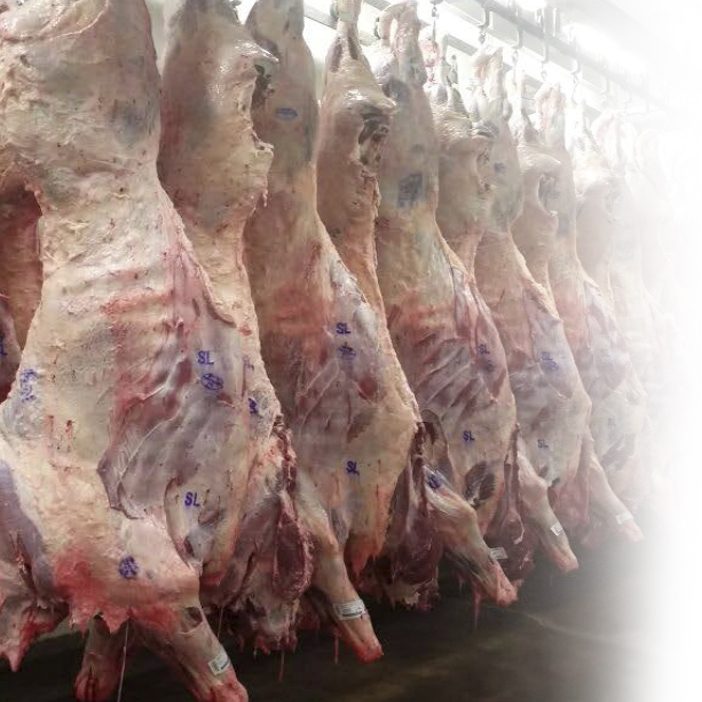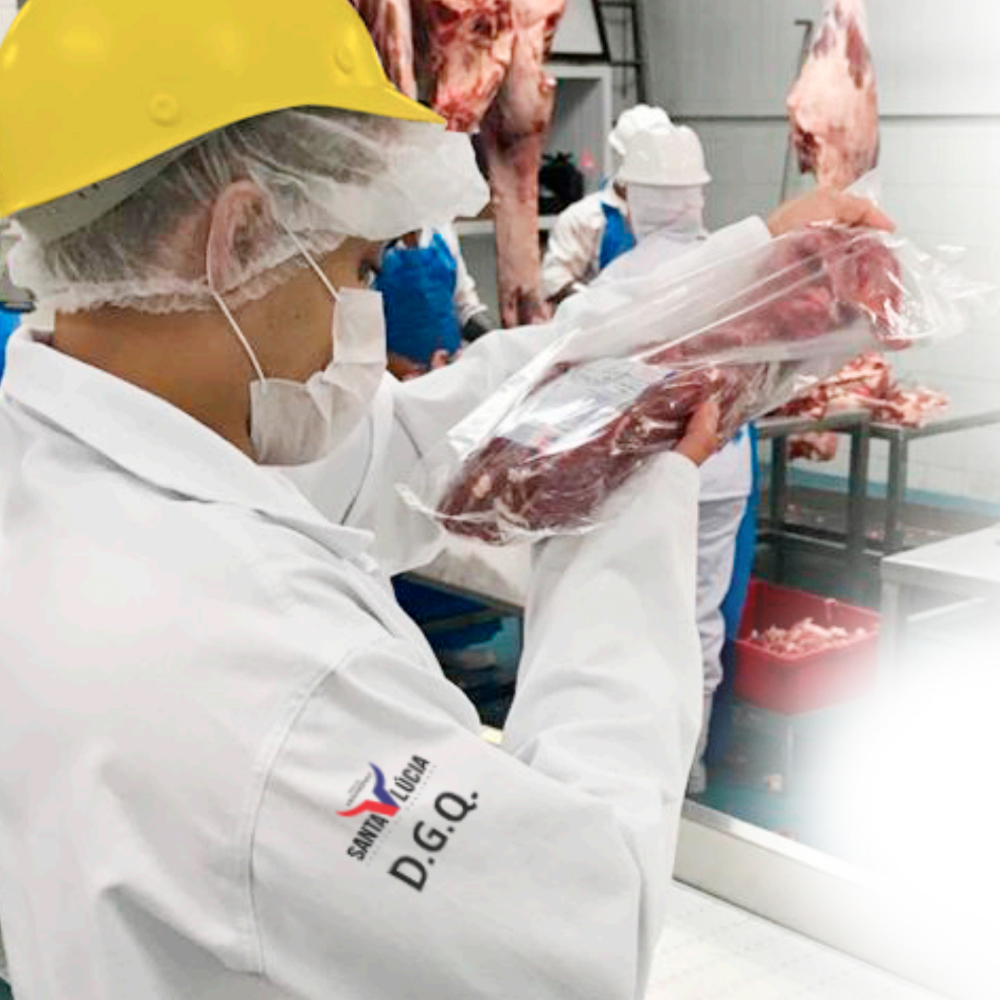A LOT OF STORY TO TELL
Our company started its work more than 50 years ago in a geographically strategic region in the Triângulo Mineiro, in the municipality of Araguari - MG. A lot has changed from that time to today, but the commitment to quality, the delivery of the best products and the highest standards of hygiene made this history last. From Minas Gerais to the world, today Frigorífico Santa Lúcia serves the national and international market.
OUR STRUCTURE
With a modern and complete structure, we value the effective care for the environment and the quality of life of our employees. In addition to respecting all the requirements of Organs competent bodies, we go further, to always bring the best.

Slaughter
--------
We are able to slaughter up to 360 animals/day, with corrals that hold 590 animals, well accommodated and respecting the animal welfare standards.
360 Animals / Day
Storage
--------
Our cooling chambers support up to 640 carcasses, equipped with equipment and cold forcing, which aid in cooling. We also have two Freezing Tunnels and a storage chamber, complying with all SIF (Federal Inspection Service) standards.
640 Carcasses
Quality Assurance
--------
We value animal welfare, quality, hygiene, adequacy of operational sanitary work processes and procedures, being intolerant of any violation of sanitary standards.
S.I.F. Brasil
Environment
--------
Frigorífico Santa Lúcia values the care for the environment, meeting 100% of the requirements of environmental agencies. In this way, our water and waste are treated and
returned to nature. We have trained and qualified employees who conduct these processes, always achieving high levels of quality.
Our
PROCEDURES

FARMERS
The quality process of our products begins with the choice of animals that we slaughter. Our producers, in addition to being great partners, are a reference in the creation of meat animals, reflecting in excellent carcass finish and meat quality. We also work with slaughter for third parties, in which our partners bring their animals and subsequently resell the carcasses under their own brand. These partners also work with the best raw materials on the market.
1

RECEIVEMENT
The process of evaluating the animals is meticulous and follows the steps required by the SIF, starting with the descent of the trucks and leading the animals to the corrals. Any diagnosed pathology is reflected in the segregation of the animal and its conduction to the Federal Inspection's observation corral, where it will undergo more specific analyzes until its final diagnosis.
2

ANIMAL ANALYSIS
The analysis process is meticulous and follows the steps required by the SIF. Starting with the descent of the truck and how the animal behaves during the journey. In case of any abnormality pointed out, the animal is taken to the observation corral of the Federal Inspection, where it will undergo more specific analyzes until its approval for slaughter or rejection.
3

STERILIZATION OF TRUCKS
After finalizing the reception of the animals, the trucks are taken to our sanitation sector, where they are washed and disinfected. Only after this procedure are they released for output.
4

ACCOMMODATION AND DRIVING OF ANIMALS
Accommodated in the corrals by lots, preserving their well-being, the animals receive an exclusively water diet until they are taken to the pre-slaughter sprinkler corrals.
5

STUNNING BOX
Forwarded to the stun box, the animals are contained and stunned in a maximum of 40 seconds, then they are hoisted and made available for bleeding in a maximum of 1 minute. After that, bleeding (section of the great vessels in the neck and heart) is performed. The other processes are carried out after a minimum time of 3 minutes, ensuring maximum blood depletion and the actual death of the animals.
6

SKIN
During the skinning process, employees work as recommended for each stage, always changing knives and washing hands, avoiding contact between the carcasses and cross contamination between them. In this process, the inspection of paws and retromammary takes place.
7

HEALTH INSPECTION
In order to guarantee the health of the products, the carcasses undergo several inspection lines, carried out by highly trained professionals: LINE A: Feet examination (in exporting establishments); LINE B: Examination of the head-tongue set; LINE C: Dental chronology (optional); LINE D: Examination of the gastrointestinal tract and spleen, pancreas, urinary vesicle and uterus; LINE E: Liver examination; LINE F: Lung and heart exams; LINE G: Examination of the kidneys; LINE H: Examination of the external and internal sides of the caudal part of the carcass and corresponding lymph nodes; LINE I: Examination of the external and internal sides of the cranial part of the carcass and pre-scapular lymph nodes.
8

TOILET AND PCC
After being inspected, the carcasses go through a final cleaning, which consists of removing excess fat, tallow and any other imperfection found in the carcasses. After cleaning, the carcasses undergo monitoring by the PCC (Critical Control Point), where they are evaluated for their innocuousness.
9

WEIGHING, CARCASS WASHING AND COOLING
After the PCC, the carcasses are weighed and receive the inspection stamp from the Ministry of Agriculture, validity, origin and traceability. Afterwards, the carcasses are washed with jets of drinking water at high pressure, and subsequently taken to the cooling chambers, where they can only be removed after reaching 7oC of temperature inside their musculature.
10

OFFAL PROCESSING
In this process, the giblets are separated and cleaned. Then, they are packaged and sent to the freezing sector.
11

BONE
At this stage, the boning and cutting of the cooled carcasses takes place, having two purposes: to be divided into smaller portions for sale or to be processed into by-products. Our deboning follows the quality team's self-control programs, where the detachment, cleaning, trimming and packaging of all the pieces are followed, ensuring a quality product and excellence in the market.
12

GREASE
The rendering plant performs the activity of processing the by-products resulting from the slaughter and deboning process, and may receive by-products from third-party butchers. The by-product of slaughtering and deboning is rich in proteins, calcium, minerals and others. In the rendering plant, Beef Meal and Bovine Bones are produced, used as raw material for the production of animal feed (except ruminants), and tallow, which is the primary material for the production of soaps, biodiesel and a multitude of other products.
13


